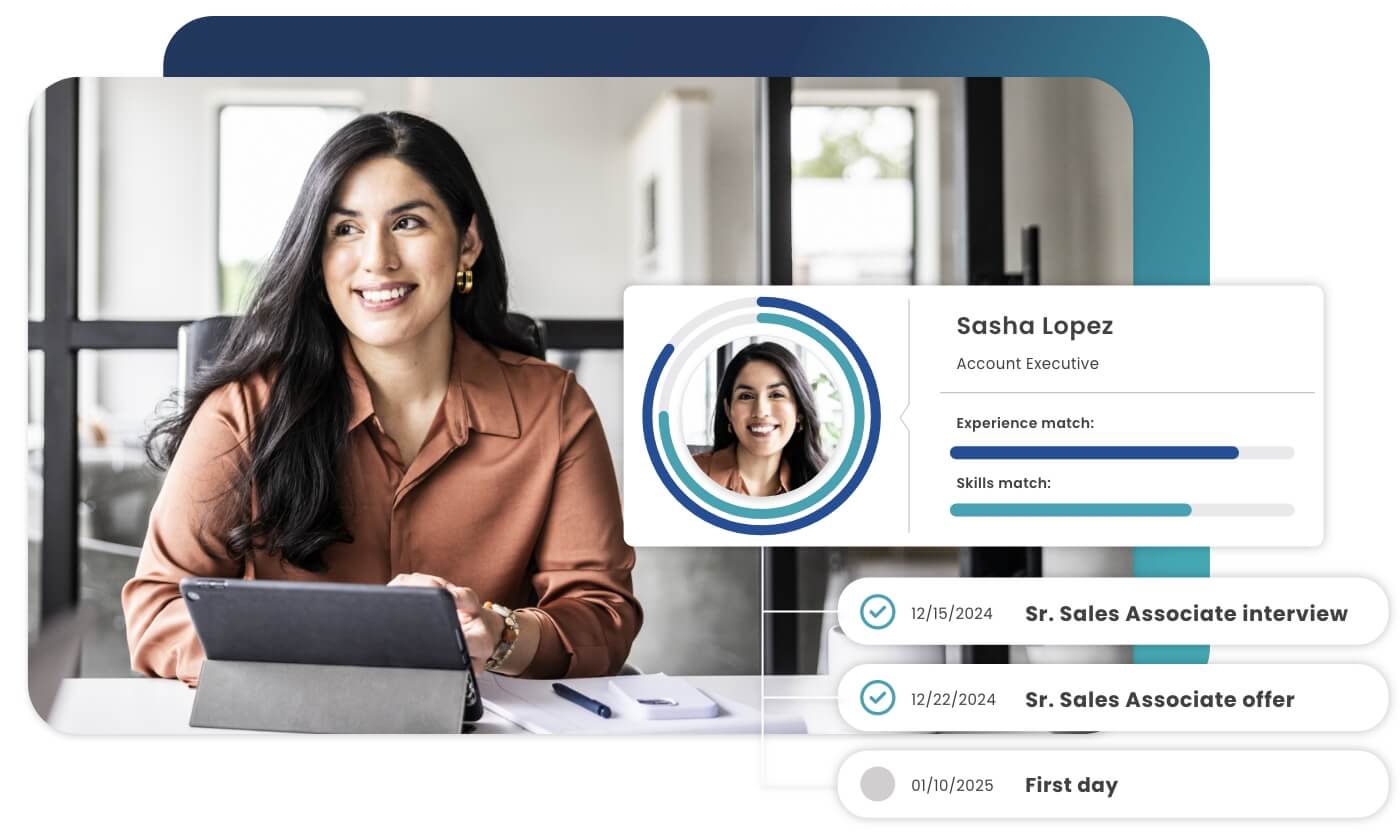

Instead of searching externally for the hire that ticks every box on your “ideal candidate” list, try looking inward. Effective internal recruiting strategies help you fill critical positions faster, reduce hiring costs and minimize the time for a hire to become fully productive.
Leveraging internal mobility is also a net win for your employee engagement and retention metrics since promoting from within and investing in career development demonstrates your company values employee growth.
As companies continue to increase their commitment to internal mobility, let’s explore how it can help you get the most return on investment (ROI) from your talent while keeping your company flexible in today’s hiring landscape.
Looking for resources to implement your internal mobility strategy? We got you covered with our internal recruiting template kit.
Internal mobility, also known as talent, employee or career mobility, describes the movement of employees between roles in a company. It includes movements like promotions, demotions, transfers and lateral transitions.
Internal mobility is an often-overlooked talent acquisition strategy. According to LinkedIn’s 2025 Workplace Learning Report, it requires collaboration from cross-functional teams and a company culture that prioritizes learning.
Many companies consider external hiring the easier option since it takes time and resources to develop effective internal mobility programs, like career development initiatives, learning and development (L&D) teams, and manager training.
But done correctly, a strong internal mobility framework boosts employee retention and satisfaction and even lowers labor costs, making it a valuable recruitment lever for enterprises with massive hiring quotas.
Curious about other underutilized recruiting strategies? Learn more about the advantages of employee referral programs for sourcing talent.
Effective internal recruiting opens your organization to enormous benefits, especially from cost and employee engagement perspectives. For example, internal mobility:
Internal mobility encompasses various types: upward, lateral, project-based, geographic and temporary.
Upward or vertical mobility involves employees moving to higher-level positions, often with additional responsibilities. Sometimes, it comes with a pay raise or access to new benefits and company perks.
Effective upward mobility is critical in any business since it serves as the pipeline for mid-level managers. It also increases employee retention since employees who are recognized and compensated for their good work are less likely to look for opportunities elsewhere.
One example of an upward mobility framework is role banding, which groups jobs into categories and levels based on compensation, responsibilities and skills. Role banding clarifies advancement expectations for senior positions, helping employees prepare more effectively.
Lateral mobility, also known as role-to-role or horizontal mobility, refers to employees who move from their current position to a new position at the same level. For example, a lateral move could be a recruitment manager moving to an IT manager position — the employee changes departments but retains the same pay and people managing responsibilities.
Supporting lateral mobility allows your employees to pursue roles that better align with their career interests, limiting the chance of disengagement and quiet quitting.
Lateral moves also broaden employees’ skill sets to adapt more easily to changing business demands. For example, a marketer who moves into an outbound sales role can use their advertising skills to craft sales pitches that attract more customers.
You can support lateral mobility in your organization through:
Project-based mobility is when employees temporarily work on short-term projects, usually with cross-functional teams.
For example, say a company decides to launch new sustainable packaging for its products. Traditionally siloed departments — design, marketing, logistics, finance and legal — must collaborate temporarily on this project to achieve success.
Project-based mobility enables stretch assignments that develop innovation, collaboration and leadership skills while building cross-departmental understanding. It also prepares high-potential employees for future opportunities that keep them engaged.
If you want to take advantage of project-based mobility, try building an opportunities marketplace for anyone to post and accept short-term internal projects. This system is an excellent way for current staff to expand their networks, gain fresh perspectives and develop new competencies through hands-on experience.
Geographic mobility, or transfers, involves moving employees to similar roles in different offices, regions or countries.
While common for multinational enterprises needing top performers in locations where they can make the most impact, it is also typical of companies that hire multiple employees for the same position. Think of a chain restaurant with several locations — a server may travel between all restaurants depending on work needs.
Geographic moves offer significant development opportunities. Sending employees to different locations allows them to enhance their leadership and cultural competency skills when working with diverse coworkers and customers. Ambitious staff also get the chance to advance in their careers through new challenges in unfamiliar environments.
But relocation also includes considerable challenges. Employees may experience financial strain, culture shock and burnout from the adjustment process. Make sure to offer generous relocation support, like relocation assistance packages and cultural training, so your talent thrives in these new surroundings.
Temporary mobility involves placing employees in short-term assignments outside their regular roles. These assignments include internships, secondments (a temporary transfer) and cross-functional projects that build capabilities while maintaining business continuity.
Here are two examples of temporary mobility in action:
The goal of temporary mobility is for employees to learn new competencies, either to improve their performance in their current role or train for future roles. Secondments, in particular, are great ways for employees to explore roles that align with their interests and test their readiness for advancement.
To avoid skill gaps and keep employees engaged, make temporary role changes part of every employee development plan. This makes evaluating promotions easier since employees who’ve completed these assignments have already demonstrated their adaptability and growth potential.
In light of the “Big Stay” phenomenon of talent, where talent chooses to remain in their roles amidst economic uncertainty, talent acquisition teams are taking advantage of internal mobility more than ever. A 2024 LinkedIn report even indicates internal mobility is up 30% since 2021.
But it can be challenging to convince executives of the long-term benefits of internal mobility compared to the short-term appeal of external hiring.
That said, you can justify and maximize the ROI of your internal mobility strategies with data:
Below, we’ll highlight the top recruitment metrics to help you evaluate the ROI of your internal versus external recruitment.
Recruitment teams often struggle to separate metrics like time-to-fill between external and internal hires, complicating the measurement of internal mobility ROI.
Additional challenges include:
A tech stack supporting data synchronization solves most of the measurement challenges mentioned above.
A fully integrated HR system allows you to identify skills gaps, assess employee competencies, and craft headcount and succession plans for filling roles efficiently. Platforms with opportunity marketplaces, skills inventories, internal job boards and AI-powered tools can identify top talent and invite them to apply for roles that match their competencies and interests.
With seamless data flow between your software tools, you can reduce manual tasks like repeated data entry while supporting more strategic decision-making.
If your current recruiting tool prevents holistic internal talent visibility, consider enterprise-grade systems like iCIMS Talent Cloud. Beyond integrating with popular HCM systems, iCIMS features configurable analytics dashboards to make monitoring and acting on your internal mobility data easier.
Methods to enhance your internal talent mobility strategy include fostering a continuous upskilling culture and aligning talent advancement with company objectives.
Employees seeking new challenges may express interest in role changes, but interest doesn’t guarantee readiness or available positions matching their goals.
To determine transition readiness, examine whether competencies and potential align with new roles. More importantly, train people managers to monitor and support direct reports’ professional ambitions.
Manager training provides tools to prepare employees for career moves through:
Encouraging employee feedback following internal moves determines what’s working in your program. Send surveys at set intervals after internal moves to gather insights. Like onboarding surveys, consider multiple touchpoints to gauge satisfaction over time.
Act on feedback to improve program areas. For example, if employees consistently report unclear job expectations post-move, train managers to provide role clarity to internal movers, including key performance indicators (KPIs).
Remember: Feedback loops provide employee perspectives, but pair them with employee readiness metrics for a complete program success picture.
Not all employee career goals align with open business roles, nor will every opening match current employee skills. However, talent acquisition specialists can work with executive, finance and HR teams to align talent with business needs.
A couple of ways include:
Under the umbrella of workforce planning, both headcount and succession planning pinpoint talent shortages, drive innovation and prepare for future needs.
Internal mobility opportunities should be accessible and fair for all employees, but they often aren’t. A 2024 LinkedIn report indicates managers and higher seniority staff are twice as likely to make internal moves than individual contributors, suggesting companies leave lower-level staff behind.
You can address this by:
Pro tip: Make fair internal mobility programs a company goal, like reducing time-to-promotion rates for lower seniority staff. This demonstrates commitment to equitable talent practices and increases company-wide participation.
Successful internal mobility requires more than a simple ATS. Instead, you need a comprehensive and scalable platform that streamlines internal job postings, talent screenings and onboarding for a smooth hiring experience.
iCIMS’ enterprise-grade solution makes short work of identifying top talent through internal talent pools, AI-powered match scoring, and reporting and analytics for tracking internal mobility metrics. Plus, with native integrations with major HCM systems, you get full visibility into how your internal recruitment efforts affect your larger organizational goals.
Schedule a free 15-minute demo to see just how iCIMS accelerates your internal moves and enables strategic workplace planning.